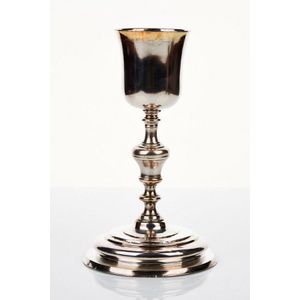Irish Georgian Silver Chalice, 19th Century
You must be a subscriber, and be logged in to view price and dealer details.
Subscribe Now to view actual auction price for this item
When you subscribe, you have the option of setting the currency in which to display prices to $Au, $US, $NZ or Stg.
- Georgian - As an English stylistic period, Georgian is usually taken to cover the period from George I (1714) to the Regency of Prince George (1811-20), although the period from 1800 to 1830 is sometimes designated as the Regency period. During the Georgian period the great English cabinetmakers and designers such as Chippendale, Hepplewhite, Adam Sheraton etc., were all active.
Therefore there isn't a single 'Georgian style' as such and to say something is 'Georgian', usually means it was made between 1714 and 1830. This assumes we discount George V and George VI, both being from the 20th century.
The styles popular at the time of each reign were:
George I (1714-1727) saw out the last years of the Baroque period.
George II (1727-1760) reigned during the Rococo period.
George III (1760-1820) saw the last gasp of the Rococo, all of the early Neo-Classic 'Adam style' and most of the later neo-Classic 'Regency style'.
George IV (Prince Regent 1820-1830)encompassed the last of the 'Regency' style.
William IV's reign (1830-1837) was something of a no man's land (stylistically) and he wasn't a 'George' anyway. He covered the last glimmerings of 'Regency' and the start of the 'Victorian' style. - Knop (silver) - A knop on a silver item is either a bulbous protrusion mid way along a stem, such as on a candlestick or at the end of a stem, such as on a spoon, or a knob or finial on top of a cover or lid, that acts as a handle. On a stemmed item such as a candlestick there may be a series of knops of different shapes.
- Hallmarks - A mark stamped on articles of precious metals in Britain, since the 14th century, certifying their purity. It derives its name from the Guild Hall of the Goldsmiths' Company, who recieved its Charter in 1327 giving it the power to assay (test the purity) and mark articles of gold and silver.
The hallmark will consist of several marks, including the:
- silver standard mark, indicating the purity of the metal. Sterling silver is .925 pure silver.
- the city mark indicating the city in which it was assayed eg London, Birmingham, York etc.
- the date mark, usually a letter of the alphabet in a particular font and case,
- a duty mark, indicating whether duty had been paid to the crown, and only in use from 1784 to 1890
The piece may include an additional mark, the maker's mark, although not forming part of the hallmark, will be located in the vicinity of the hallmarks.
Sometimes silver plated items will bear faux hallmarks, often confusing those not familiar with silver markings. - Sterling Silver - Sterling silver is a mixture of 92.5% pure silver and 7.5% of another metal, usually copper. Fine silver is 99.9% pure silver, and is relatively soft and the addition of the very small amount of copper gives the metal enough strength and hardness to be worked into jewellery, decorative and household objects.
- Chalice - A chalice is a large cup or goblet that is used in religious ceremonies, particularly in Christian liturgical traditions. It is typically made of precious metal such as gold or silver, and is used to hold wine during the Eucharist, which is the central sacrament of the Christian Church. The chalice is also called the "cup of salvation" and is a symbol of Jesus' sacrifice on the cross.
In the Christian tradition, the chalice is a symbol of the blood of Jesus Christ, which is offered to the faithful as a means of grace and salvation. The chalice is used to hold the wine that is consecrated during the Eucharist and is considered to be a sacred object.
In the liturgical celebration of the Eucharist, it's passed around to the faithful, and the believer drinks from it to partake in the sacrament. Chalices are also used in other liturgical celebrations such as baptism, confirmation and anointing of the sick.
Chalices come in different shapes and sizes, from simple cups to highly ornate and decorative vessels, some of them are adorned with precious stones and intricate engravings. Chalices can also be used for other purposes, such as for holding holy water for baptism, or for the distribution of ashes on Ash Wednesday.
This item has been included into following indexes:
Visually similar items

Continental silver chalice, possibly German, with gilded interior, on a stepped circular foot, hallmarked, weight 427 grams

Two small Victorian Deceptive glasses, 19th century, comprising a facet cut bucket bowl glass with an annulated knop, and a small conical glass with twin compressed knops, both raised on conical bases. Height 10 cm, and 8.5 cm

An antique silver trophy cup engraved '1st Prize Helvetia Cup, won by Col. Serg.t Jas. Vincent at the Swiss Rifle Club, 24th October, 1866'. 28 cm high

A George III Irish Provincial silver goblet by Caren Terry and Jane Williams of Cork, hallmarked at Dublin 1817. 12 cm high.
